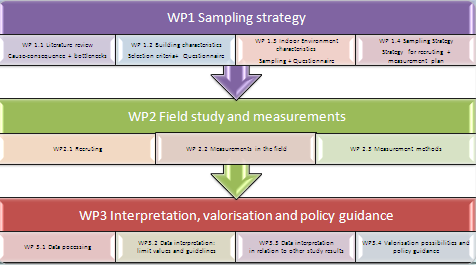In a first phase (1) a detailed measuring strategy is designed, based on open literature on (inter)national studies and reviews concerning cause-consequence- solution research on the indoor environment of sustainable ventilated buildings. Advantages as well as bottlenecks in relation to energy-efficient, ventilated buildings, are included in this literature review. The indoor environment, and the influence of the outdoor environment on the indoor air is included as well. This implies a study on chemical, physical and biological contamination. Based on this review, priority selection criteria for buildings are distinguished from parameters to be measured on-site or to be included in a building-related questionnaire.
In the second phase (2) in total 50 buildings, of which 25 houses and 25 schools/classrooms in Flanders, Belgium are be selected. These 50 buildings have a building envelope and ventilation system type, that is representative for the current and future building patrimony in Flanders. These include passive house constructions as well as low-energy buildings, and ventilation systems with controlled in-and outlet as well as systems with controlled outlets.
The sampling campaign (phase 3) focuses on chemical, physical, and biological characterisation of the indoor environment in sustainable buildings. This implies a physico-chemical analysis of the indoor environment as well as the corresponding outdoor air; the identification of fungi, yeast and bacteria inside the houses and schools, the measurements of noise nuisance due to building ventilation, and the measurement of the effectiveness of the ventilation system in relation to the theoretical ventilation and air infiltration.
This large dataset will allow an exploratory comparison between the indoor environments of passive, low-energy and traditional houses and schools in Flanders, and will also allow an evaluation of the different ventilation system types.
The conclusions of this research will lead to the formulation of policy options and policy guidance for environmental policy and other entities. Practical guidelines for citizens will also result from this research. For this reason, in the building selection phase significant attention will be put on the level of possible extrapolation of the data, which will be obtained in a relatively limited set of buildings, to the whole region of Flanders.
